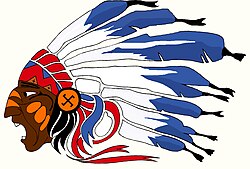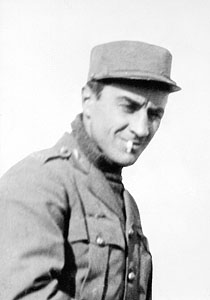Loading AI tools
U.S. volunteer unit constituted in 1916 under French command From Wikipedia, the free encyclopedia
The La Fayette Escadrille (French: Escadrille de La Fayette) was the name of the French Air Force unit escadrille N 124 during the First World War (1914–1918). This escadrille of the Aéronautique Militaire was composed largely of American volunteer pilots flying fighters. It was named in honor of the Marquis de Lafayette, French hero of the American Revolutionary War. In September 1917, the escadrille was transferred to the United States Army under the designation 103rd Aero Squadron. In 1921, the French Air Force recreated a N124 unit who claimed lineage from the war-time La Fayette escadrille and is now part of the escadron 2/4 La Fayette.

| Escadrille La Fayette | |
|---|---|
 Insignia of the N 124 La Fayette Escadrille | |
| Active | 1916–1917 |
| Allegiance | France |
| Branch | Aéronautique Militaire Military Aeronautics |
| Type | Fighter Squadron |
| Engagements | World War I |




Dr. Edmund L. Gros, a founder of the American Hospital of Paris and organizer of the American Ambulance Field Service, and Norman Prince, a Harvard-educated lawyer and an American expatriate already flying for France, led the attempts to persuade the French government of the value of a volunteer American air unit fighting for France. The aim was to have their efforts recognized by the American public and thus, it was hoped, the resulting publicity would rouse interest in abandoning neutrality and joining the fight. Authorized by the French Air Department on March 21, 1916, the Escadrille de Chasse Nieuport 124 (Escadrille Américaine) was deployed on April 20 in Luxeuil-les-Bains, France, near Switzerland's border.[1][2] Despite the unit's weak notorious status in the United States, the Escadrille proved useful for the French and Americans, taking into consideration that before the First World War, aircraft were not considered combat units. Initially, there were seven Americans pilots: Victor E. Chapman, Elliott C. Cowdin, Bert Hall, James Rogers McConnell, Norman Prince, Kiffin Rockwell, and William Thaw II.[3] The full roster included 38 pilots.[citation needed]
The unit's aircraft, mechanics, and uniforms were French, as was the commander, Captain Georges Thénault. Five French pilots were also on the roster, serving at various times in command positions. Raoul Lufbery, a French-born American citizen, became the squadron's first, and ultimately their highest scoring flying ace, with 16 confirmed victories.[4]
Two unofficial members of the Escadrille Américaine, lion cubs named Whiskey and Soda, provided countless moments of relief from battle stress to fliers.[5]
A German objection filed with the U.S. government, over the actions of a supposed neutral nation, led to the name change to La Fayette Escadrille in December 1916, as the original name implied that the U.S. was allied to France rather than neutral.[6]
The Escadrille was disbanded on 18 February 1918. The American personnel transferred to the United States Army Air Service as the 103d Aero Squadron, while the French formed the Escadrille SPA.124 Jeanne d'Arc. A total of 224 Americans served in the unit. Of those, 51 died in combat, while another 11 died of other causes. Fifteen became prisoners of war. Eleven pilots became aces.[7]: 193
Not all American pilots were in the Lafayette Escadrille; over 200 fought for France as part of the La Fayette Flying Corps.[N 1] On 3 April 1918, eleven American pilots from the Air Service of the American Expeditionary Force were assigned to Escadrille N.471, an air defense squadron stationed near Paris.[N 2] American flyers served with this French unit until 18 July 1918, and it is sometimes referred to as the Second Escadrille Américaine.[11]
Later, the Escadron de Chasse 2/4 La Fayette retook the unit designation of "La Fayette", this time however in the French Air Force.[12]

The first major action seen by the squadron was 13 May 1916 at the Battle of Verdun and five days later, Kiffin Rockwell recorded the unit's first aerial victory.[6] On 23 June, the Escadrille suffered its first fatality when Victor Chapman was shot down over Douaumont.[6][13] The unit was posted to the front until September 1916, when the unit was moved back to Luxeuil-les-Bains in 7 Army area. On 23 September, Rockwell was killed when his Nieuport was downed by the gunner in a German Albatros observation plane[14] and in October, Norman Prince was fatally injured after crashing on final approach to his airfield.[15] The squadron, flying Nieuport, later Spad, scouts, suffered heavy losses, but it received replacements until a total of 38 American pilots eventually served with the squadron. So many Americans volunteered to fly for France that they were eventually farmed out to other French squadrons. As a group, the Americans who flew in the war for France's air service, the Aéronautique militaire, are collectively known as the La Fayette Flying Corps. Altogether, 265 American volunteers served in the corps.[citation needed]
On 8 February 1918, the squadron was disbanded, and 12 of its American members inducted into the U.S. Air Service as members of the 103rd Aero Squadron. For a brief period, it retained its French aircraft and mechanics. Most of its veteran members were set to work training newly arrived American pilots. The 103rd was credited with a further 45 kills before the Armistice went into effect on 11 November.[16] The French Escadrille SPA.124, also known as the Jeanne d'Arc Escadrille, continued Lafayette Escadrille's traditions in the Service Aéronautique.[citation needed]

| Equipment | Beginning | End |
|---|---|---|
| Nieuport 11 – Bébé | January 1916 | March 1916 |
| Société Pour L'Aviation et ses Dérivés SPAD VII | May 1916 | 1928 |
| Nieuport 17 | January 1916 | November 1928 |
Nine pilots died in the Lafayette Escadrille while others perished after leaving the unit. More sustained non-fatal injuries. The planes flown were flimsy, and not as safe as those of later years. Engines and other parts failed, and machine-guns often jammed when they were needed. One man asked to be moved back to his infantry unit, where "he could be safe." The first pilot to be killed in action was Victor Chapman.[17] Edmond Genet became the first American casualty of World War I following the U.S. entry into the war. Other Americans had died previous to the U.S. declaration of war, but since Genet had been active in the Escadrille since before the U.S. entry into the war, his death only a few days after the U.S. declaration of war made him the first official U.S. casualty.[citation needed]
This section needs additional citations for verification. (August 2021) |



After the Great War, membership in the Escadrille Lafayette was claimed by over 4,000 people, "including a dozen well-known Hollywood personalities and several high government officials.[18]
Also, from the beginning there was a great deal of confusion between American pilots who were members of the Lafayette Escadrille, a designated all-American aviation squadron of the French Service Aeronautique; and the Lafayette Flying Corps, an unofficial paper organization highlighting in its roster published during the war the names of approximately 231 American volunteer aviators who flew with more than 90 French operational escadrilles.[19][20] Already existing confusion was exacerbated after a screening of the film Flyboys in 2006.
Five French officers and 38 American pilots, also known as "The Valiant 38", were members of the Lafayette Escadrille.[21][22]
A Cross (†) indicates that the individual was killed in action, including those who subsequently entered the Air Service, or died of wounds received.
The Group La Fayette totalized eight citations at the orders of Air Army, bearing the right to wear the Fourragere with ribbon colors of the Croix de guerre 1914–1918 (France), as well as the Fourragere with ribbon colors of the Médaille Militaire.

At the decommission of the unit on January 1, 1918, the following registry noted:


La Fayette Escadrille became the third flight unit (Escadrille) of the Groupe de Chasse 2/5 La Fayette.
| Nom | Commandment Start | Commandment End |
|---|---|---|
| Captain Monraisse | September 1939 | October 3, 1940 |
| Lieutenant Villacèque | October 4, 1940 | January 19, 1944 |
| Lieutenant de Monplanet | January 20, 1944 | May 8, 1945 |
| Equipment | Beginning | End |
|---|---|---|
| Curtiss H75 | September 1939 | November 1942 |
| July 1940 | September 1940 | |
| October 1942 | November 1942 | |
| November 1942 | March 1943 | |
| March 1943 | March 1944 | |
| Republic P-47D Thunderbolt | May 1944 | May 1945 |

The group was the subject of one of the "We Were There" historical books for young adults.
The story of the Lafayette Escadrille has been depicted in three feature films:
The Lafayette Escadrille also appears in "Attack of the Hawkmen", an episode of The Young Indiana Jones Chronicles in which Indy is temporarily assigned to the group as an aerial reconnaissance photographer.
The exploits of the Lafayette Escadrille are also captured in several works of historical fiction including: Falcons of France by Charles Nordhoff and James Norman Hall (1929) and To the Last Man by Jeffrey Shaara .
The Lafayette Escadrille is part of the 2018 short documentary Raoul Lufbery: Fighter Ace. The film subject is fighter ace Raoul Lufbery, it was directed by Alexander Zane Irwin and produced by Daniel Bernardi with the collaboration of El Dorado Films and the Veteran Documentary Corps.[25]
Seamless Wikipedia browsing. On steroids.
Every time you click a link to Wikipedia, Wiktionary or Wikiquote in your browser's search results, it will show the modern Wikiwand interface.
Wikiwand extension is a five stars, simple, with minimum permission required to keep your browsing private, safe and transparent.